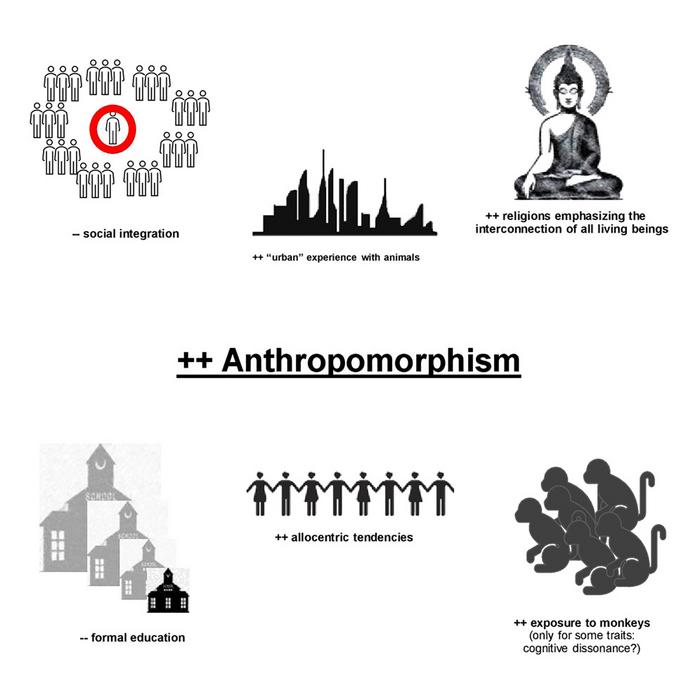In the quest to safeguard endangered species and foster global conservation efforts, a deeply ingrained human tendency—anthropomorphism—plays a pivotal role. Anthropomorphism, the psychological practice of ascribing human characteristics, emotions, or intentions to non-human entities, is not only a widespread cultural phenomenon but also a significant driver of public response towards wildlife preservation. A groundbreaking study published June 18 in the journal iScience by Federica Amici and colleagues from Leipzig University sheds light on the intricate social and cognitive factors that influence why and how individuals assign humanlike qualities to animals across diverse cultures.
This multi-national research draws on survey data collected from 741 adults spanning five countries—Brazil, Indonesia, Mexico, Malaysia, and Spain—capturing a varied spectrum of cultural backgrounds and experiences interacting with animals. The team engineered a comprehensive questionnaire designed to probe participants’ upbringing, social integration levels, urban life exposure, formal education, and religious beliefs alongside their perceptions of animals’ physical similarity to humans and their capacities for emotion, consciousness, and free will. What emerged from this large-scale social inquiry was a nuanced portrait of anthropomorphism as a behavior influenced by complex interplay among social context, cognitive frameworks, and cultural paradigms.
One of the study’s most striking revelations is the influence of social integration on anthropomorphic tendencies. Individuals who experience social isolation or chronic loneliness demonstrate a markedly greater propensity to attribute humanlike emotional states and conscious intent to animals. This behavior seemingly functions as a psychological mechanism to fulfill unmet social connection needs, wherein animals serve as surrogate companions perceived to possess genuine thoughts and feelings. The implications are profound, especially considering how digital-age urbanization often engenders social fragmentation, potentially enhancing anthropomorphic perceptions as a coping strategy.
.adsslot_84y20OCzL7{width:728px !important;height:90px !important;}
@media(max-width:1199px){ .adsslot_84y20OCzL7{width:468px !important;height:60px !important;}
}
@media(max-width:767px){ .adsslot_84y20OCzL7{width:320px !important;height:50px !important;}
}
ADVERTISEMENT
Urban experiences themselves further augment the tendency to anthropomorphize. Participants with greater exposure to pets, frequent zoo visits, or media consumption featuring animals consistently reported higher degrees of attributing consciousness, emotions, and intentionality to animal species. Frequent interaction with animals in constructed environments or through mediated realities arguably bridges psychological distance and fosters a perception of animals as sentient, conscious agents akin to humans. Conversely, paradoxically, individuals with more extensive formal education manifested a lower likelihood of ascribing autonomous mental states to animals, perhaps reflecting training in critical thinking or empiricism that tempers intuitive empathic projections.
Religious affiliation notably emerged as another determinant shaping anthropomorphic perspectives. The survey unveiled a clear dichotomy between monotheistic and non-monotheistic religious traditions. Those raised within monotheistic faiths such as Christianity and Islam tended to ascribe less consciousness or free will to animals. In contrast, adherents of polytheistic or non-monotheistic religions, including Buddhism and Hinduism, demonstrated greater openness to perceiving animals as conscious beings endowed with intentionality. Agnostics and atheists clustered closer to the monotheistic group in their skepticism toward animals’ autonomy. This division reflects underlying theological frameworks and cosmologies that mediate humans’ conceptual boundaries between themselves and other species.
The research resonates deeply within conservation science, where anthropomorphism functions as a double-edged sword. On one hand, animals exhibiting humanlike traits or behaviors tend to elicit stronger empathy, leading to increased funding and public support vital for conservation success. Iconic species such as pandas or polar bears, often anthropomorphized in media and campaigns, benefit from this bias. However, this skewed attention risks eclipsing less charismatic but ecologically crucial species, potentially undermining holistic ecosystem preservation goals. Amici cautions conservationists to wield anthropomorphic narratives thoughtfully, blending emotive appeal with education about the ecological roles and importance of diverse species.
Intriguingly, the study emphasizes that anthropomorphism should not be simplistically viewed as a universal good or bad within conservation contexts. Instead, it serves as a nuanced cognitive and emotional lens through which humans relate to nature—a lens shaped by social integration, cultural milieu, education, and spiritual values. Cognizance of such underlying biases enables conservationists and policymakers to tailor outreach strategies more effectively, optimizing public engagement without compromising ecological rigor.
While the study aggregates broad global trends, the authors acknowledge limitations related to sample representation and cultural heterogeneity within surveyed populations. The complexity of anthropomorphism warrants further interdisciplinary studies integrating behavioral psychology, anthropology, and conservation biology to unravel the layered mechanisms driving human–animal relational dynamics. Advancements in neurocognitive tools and cross-cultural analyses promise to deepen understanding of how anthropomorphism interfaces with empathy, moral cognition, and decision-making concerning wildlife protection.
This research also invites reflection on the broader societal transformations shaping human perceptions of the natural world, particularly amid accelerating urbanization and technological mediation of experiences with biodiversity. As everyday interactions with wildlife become increasingly indirect, animals may assume amplified symbolic roles within social and individual identities. These shifts necessitate adaptive conservation narratives that resonate within contemporary cognitive ecologies while respecting biological realities and ethical considerations.
Ultimately, the investigation conducted by Amici et al. underscores the profound psychological dimensions underlying conservation challenges—dimensions that transcend biology to encompass the social and spiritual fabrics of human life. Harnessing the power of anthropomorphism with scientific awareness and cultural sensitivity presents a promising avenue to galvanize inclusive, sustainable conservation initiatives in the Anthropocene epoch.
Subject of Research: People
Article Title: Experience with animals, religion and social integration predict anthropomorphism across five countries
News Publication Date: 18-Jun-2025
Web References: http://dx.doi.org/10.1016/j.isci.2025.112693
Image Credits: iScience/Amici et al.
Keywords: Cultural diversity, Sociological data, Social surveys, Behavioral ecology, Human social behavior, Animal psychology
Tags: anthropomorphism in wildlife conservationcognitive biases in animal behavior interpretationcross-cultural comparisons of animal emotionscultural perceptions of animal intelligenceeducation’s role in animal empathyhuman-animal relationships and conservationpsychological influences on species preservationpublic response to endangered speciesreligious beliefs and animal intelligencesocial factors affecting animal empathysurvey research on animal consciousnessurban living and animal perceptions





